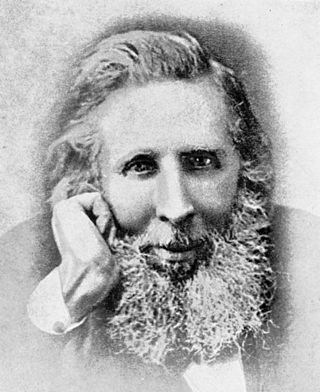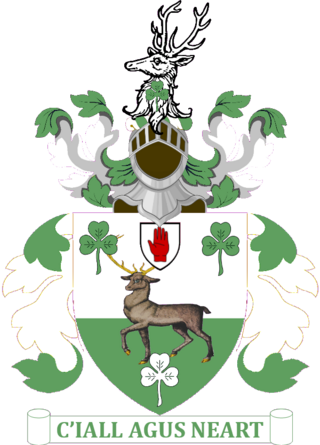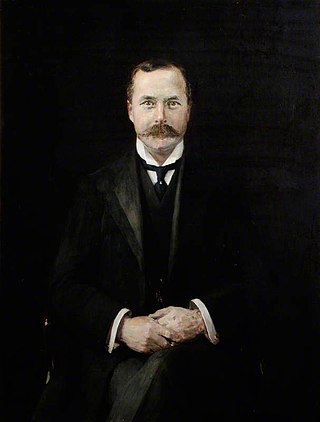Related Research Articles

Sir William Robert Wills Wilde FRCSI was an Irish oto-ophthalmologic surgeon and the author of significant works on medicine, archaeology and folklore, particularly concerning his native Ireland. He was the father of Oscar Wilde.

Merrion Square is a Georgian garden square on the southside of Dublin city centre.

Bunratty Castle is a large 15th-century tower house in County Clare, Ireland. It is located in the centre of Bunratty village, by the N18 road between Limerick and Ennis, near Shannon Town and its airport. The castle and the adjoining folk park are run by Shannon Heritage as tourist attractions.

Charles-Édouard Brown-Séquard FRS was a Mauritian physiologist and neurologist who, in 1850, became the first to describe what is now called Brown-Séquard syndrome.

Ashford Castle is a medieval and Victorian castle that has been expanded over the centuries and turned into a five star luxury hotel near Cong on the Mayo-Galway border, on the Galway side of Lough Corrib in Ireland. It is a member of the Red Carnation Hotels organisation and was previously owned by the Guinness family.

Dr Steevens' Hospital, one of Ireland's most distinguished eighteenth-century medical establishments, was located at Kilmainham in Dublin Ireland. It was founded under the terms of the will of Dr Richard Steevens, an eminent physician in Dublin. The seal of the hospital consisted of 'The Good Samaritan healing the wounds of the fallen traveller' with the motto beneath "Do Thou Likewise".
Charles Edward McCausland was an Irish cricketer. A right-handed batsman and right-arm fast-medium bowler, he played four times for the Ireland cricket team in the 1920s, including two first-class matches against Scotland. He also played first-class cricket for Dublin University.

Sir Henry Marsh, 1st Baronet was an Irish physician and surgeon. He was born in Loughrea, County Galway in Ireland. He was one of the medical doctors associated with Basedow's syndrome, which is also known as Marsh's disease and currently as Graves' disease.

Moore Hall, or Moorehall, the house and estate of George Henry Moore and family, is situated to the south of the village Carnacon in the barony of Carra, County Mayo in a karst limestone landscape.
McCausland, meaning "Son of Absolom" is a surname of Irish origin; there is also a clan of this name in Scotland. The family claim descent from the Cenel Eoghain race in County Londonderry and Tyrone, a branch of the Ui Neil.
William Malachy Burke was an Irish physician and Registrar General.
The High Sheriff of Leitrim was the British Crown's judicial representative in County Leitrim, Ireland from c.1582 until 1922, when the office was abolished in the new Free State and replaced by the office of Leitrim County Sheriff. The sheriff had judicial, electoral, ceremonial and administrative functions and executed High Court Writs. In 1908, an Order in Council made the Lord-Lieutenant the Sovereign's prime representative in a county and reduced the High Sheriff's precedence. However the sheriff retained his responsibilities for the preservation of law and order in the county. The usual procedure for appointing the sheriff from 1660 onwards was that three persons were nominated at the beginning of each year from the county and the Lord Lieutenant then appointed his choice as High Sheriff for the remainder of the year. Often the other nominees were appointed as under-sheriffs. Sometimes a sheriff did not fulfil his entire term through death or other event and another sheriff was then appointed for the remainder of the year. The dates given hereunder are the dates of appointment. All addresses are in County Leitrim unless stated otherwise.
The Sheriff of County Dublin was the Sovereign's judicial representative in County Dublin. Initially, an office for a lifetime, assigned by the Sovereign, the Sheriff became an annual appointment following the Provisions of Oxford in 1258. The first recorded Sheriff was Ralph Eure, appointed in that year. The next recorded Sheriff was Sir David de Offington, who was Sheriff in 1282. Besides his judicial importance, the sheriff had ceremonial and administrative functions and executed High Court Writs.

Sir James O'Connell, 1st Baronet was an Irish baronet and younger brother of Daniel O'Connell.

Newtown Castle is a 16th-century tower house, located close to the village of Ballyvaughan within the Burren area of County Clare, Ireland. Uniquely for a tower house of its type in Ireland, Newtown Castle is mostly cylindrical in shape but rises from a square pyramidical base. It is today part of the Burren College of Art.
John Ormsby Vandeleur was an Irish barrister, landowner and politician from Kilrush in County Clare. He sat in the House of Commons of Ireland from 1790 to 1800, and then in the House of Commons of the United Kingdom from 1801 to 1802.

John Charles William Coppinger O’Connell, later known as John Charles William Coppinger O’Connell Bianconi was an Irish land-owner and entrepreneur active in Clare.

Sir Peter Freyer was an Irish surgeon with an expertise in genitourinary surgery, best known at first as an Indian Medical Service (IMS) officer, for making popular the procedure for crushing bladder stones to allow them to be evacuated through the natural passages, a procedure known as a litholapaxy. Following retirement from the IMS after 20 years of service in India, he returned to England and popularized a procedure for benign large prostates. This was known as the suprapubic prostatectomy, a transvesical prostatectomy or the Freyer operation, where the prostate is removed through an abdominal incision above the pubic bone but below the umbilicus and through the bladder, and it included using suprapubic drainage post-operatively.
Alice Reeves RRC was an Irish nurse and matron of Dr Steevens’ Hospital, Dublin. Described by surgeon, T. G. Wilson, as "undoubtedly one of the greatest nurses Ireland has ever produced." Reeves helped create the first rules of the general nursing council in the 1920s and she received the honour of a Florence Nightingale Medal.
References
- ↑ Kelcran Genealogy
- ↑ British Medical Journal Death Notice for McCausland 1933
- ↑ "Judges of the Past". Supreme Court of Singapore.
- ↑ Landed Estates, NUI Galway. Accessed 25 January 2023.
- ↑ Landed Estates, NUI Galway. Accessed 25 January 2023.
- ↑ 1901 Census Return for 79 Merrion Square
- ↑ Doctor Steevens Hospital: A brief history by Davis Coakley; ISBN 978-0951982204
- ↑ "Pins agus needles: I wasn't very gifted at Irish", by Maurice Gueret, The Irish Independent , 27 October 2014.
- ↑ Charles-Edouard Brown-Séquard: The Biography of a Tormented Genius by Louis-Cyril Celestin, p. 229
[